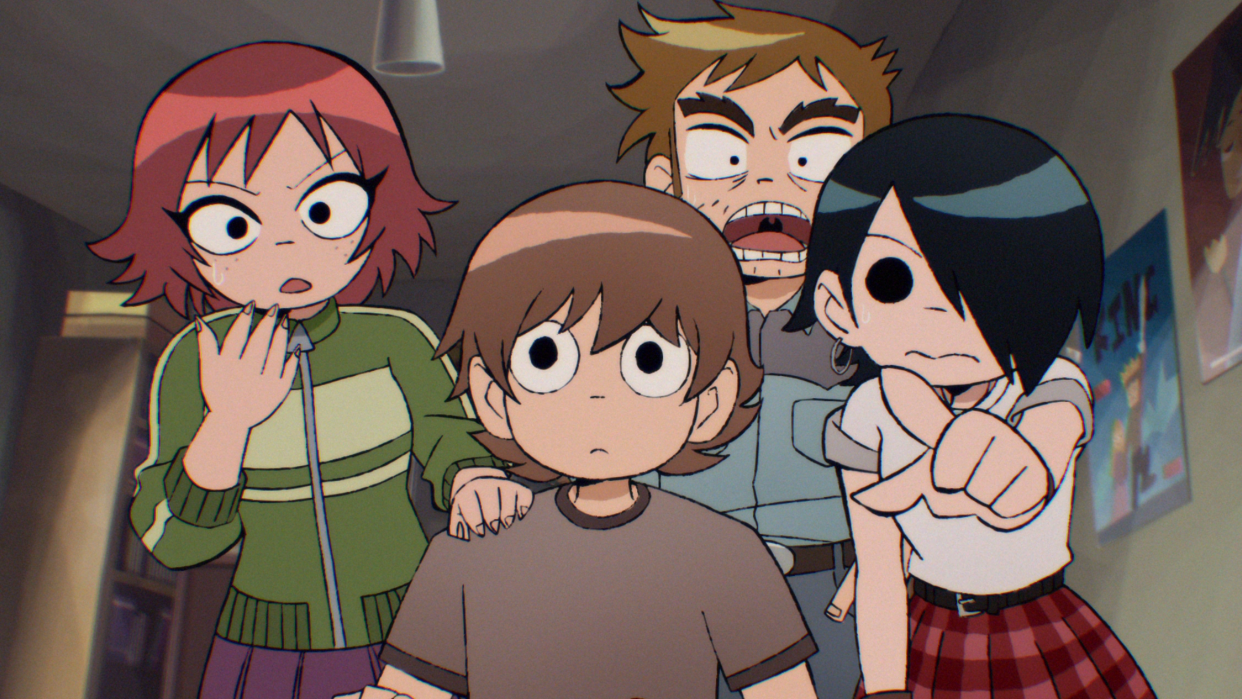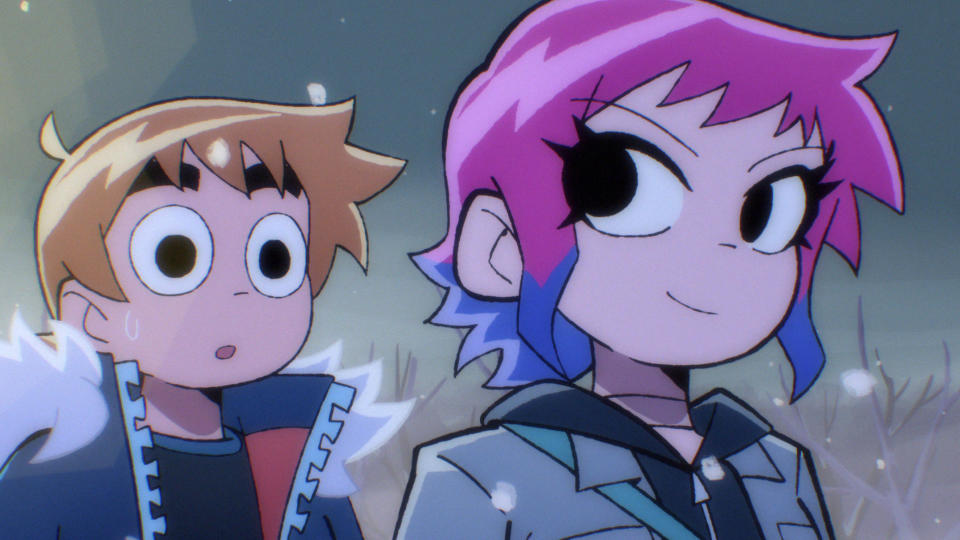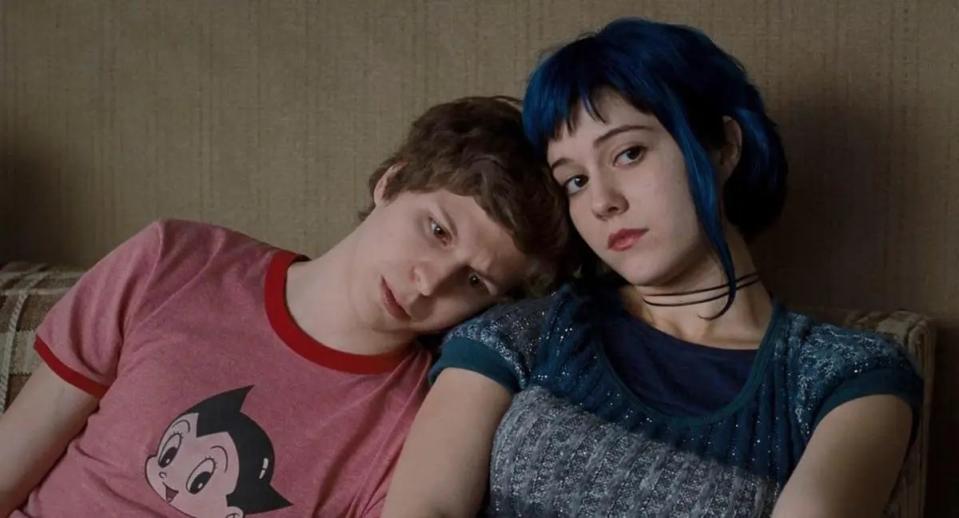Bryan Lee O’Malley Wanted ‘Scott Pilgrim Takes Off’ to Surprise You

[Editor’s note: The following story contains spoilers for “Scott Pilgrim Takes Off.” ]
When “Scott Pilgrim’s Precious Little Life” first released in August 2004, a key part of the graphic novel’s premise was a major third-act surprise. Some talk of “subspace travel” aside, the first 100 pages of Bryan Lee O’Malley’s breakout hit tell an ordinary slice-of-life tale about an unemployed Canadian slacker, his terrible band, the 17 year-old he’s sort of dating, and the cool American girl he actually wants to date. In the comic’s third act, title hero Scott gets assaulted on stage by Matthew Patel, one of the seven evil exes of Ramona Flowers, and the story suddenly reveals that A) Scott is one of the best hand-to-hand fighters in Toronto and B) everything is taking place in a universe that obeys video game logic, with crazy superpowers and extra lives and level ups.
More from IndieWire
Martin Scorsese and Steven Spielberg Are Exec Producing a 'Cape Fear' Series
Why So Many Hollywood Execs Have April 8, 2024 Circled on Their Calendar
At the time, the climax of “Precious Little Life” was a massive rug-pull moment. And then O’Malley wrote five more “Scott Pilgrim” graphic novels. And then Edgar Wright turned the series into a movie that flopped at the box office but became a cult internet favorite. And then the franchise got turned into a beat ’em up 16-bit video game. Nowadays, anyone who picks up the original graphic novel is likely waiting impatiently for the other shoe to drop and for Patel to arrive so the crazy, video game-inspired fights can begin. So when O’Malley was approached by Japanese animation studio Science Saru about turning his beloved property into an anime, he knew he wanted to take that first fight with Patel and flip it on its head.
“That was really shocking to people at the time,” O’Malley said in a recent interview with IndieWire. “And now when I think about writing ”Scott Pilgrim’ when ‘Scott Pilgrim’ already exists, any 15 year-old can go on Wikipedia and read the synopsis of ‘Scott Pilgrim.’ Like, it takes two seconds or you’ve already heard about it from your cousin or whatever. So, I wanted to find a way to gain the upper hand in terms of surprise. I just think that makes it more fun and feel more alive, if you don’t know what’s going to happen next.”
Throughout most of “Scott Pilgrim Takes Off,” which premiered on Netflix Friday, fans won’t have any idea what’s going to happen next. After a first episode that mostly follows the basic storyline of “Precious Little Life” — its most notable change is that Ramona (voiced by Mary Elizabeth Winstead, one of the many cast members from the 2010 movie to reprise their role) now works as not just a DVD delivery woman but specifically a Netflix DVD delivery woman — the fight with Patel (Satya Bhabha) ramps up for an epic showdown. And then it just abruptly ends, when Scott (Michael Cera) seemingly dies after one punch. From there, the original comic’s indie rom-com storyline gets thrown out the window, and Ramona becomes the main character, playing detective to determine what happened to the guy she just met.
The result is that, some meta antics involving a film about Scott’s life aside, “Scott Pilgrim Takes Off” is almost completely lacking in Scott Pilgrim for a good five episodes. The show is more a remix than retelling of O’Malley’s original comics, throwing the characters and the disparate parts into a blender to create something totally new.

“Scott Pilgrim Takes Off” is O’Malley’s first time writing for TV — he’s credited as a writer on every episode with his co-creator and friend, BenDavid Grabinski. But rather than just stick with a straightforward remake of his work, O’Malley wanted to use the opportunity to go in fresh directions; with Science Saru and director Rob Bell focusing on recreating the original book’s chibi art design — “They’re much more talented than I am at drawing. I was blissfully kind of hands off for that whole visual process,” he said — he and Grabinski could focus purely on the storyline.
“If the audience is just like, ‘Is this scene as good as the original?’ Every scene you’re thinking that?” O’Malley said. “I was scared of being that bored for that long.”
Over the course of its eight episodes, “Takes Off” pivots away from the central character in favor of a broader ensemble story; O’Malley said that in particular he and Grabinski wanted to expand their focus on Ramona, hence her front and center placement in the series, and on her Seven Evil Exes, almost all of whom are redeemed and given way more screentime than the original story afforded; Patel, for example, goes from the one note starter villain to a major presence who takes control of the League and is revealed to have a major love for Broadway musicals.
A few of the expanded storylines for characters — like expanded backstories for Evil Exes Roxy and the Katayanagi twins — came from ideas O’Malley had from when he was writing the original indie comic books that didn’t quite make the final cut. Other divergences are wholly original concepts that O’Malley brainstormed with Grabinski, like a childhood connection between League of Evil Exes head Gideon Graves (Jason Schwartzman) and Scott’s frenemy Julie Powers (Aubrey Plaza) that never popped up in any other iteration of the franchise.
O’Malley explained that the sympathetic backstory they dreamed up for the previously completely unsympathetic Gideon — where he was a nerd named Gordon Goose who changed his name and developed a new identity after years of bullying — was in part inspired from his own youth, down to the fact that both were made to hail from North Bay, Ontario: “When I was working on the books, I thought ‘Gideon is going to be me. Scott is me at the beginning and Gideon is me at the end.’ Gideon is like 31, which is the age I was when I was doing the last book,” he said. The new backstory makes the parallels between the two, where Gideon embodies all of Scott’s worst traits with none of the good, more explicit while at the same time softening him in the hero’s absence. His eventual romance with Julie, usually a minor plot-irrelevant character, came from a simple desire to have Schwartzman and Plaza act in a few scenes together.
For Knives Chau (Ellen Wong, a standout in the voice cast), Scott’s 17-year-old sort-of girlfriend whose obsessive crush storyline has always been the saddest part of the franchise, the removal of Scott provided her opportunity for an arc that “was not about boys or romance,” as O’Malley put it, but instead about her own self-discovery. In this iteration, Knives’ bonds with Sex Bo-Bomb leader Stephen Stills (Mark Webber) in her exes’ absence, and her subplot sees her go from a groupie for the band to a vital member who pushes the group to success after a gorgeous scene where she picks up and plays Scott’s bass guitar for the first time.
“That was a very important scene for me. it’s the kind of thing that you can never do in a comic because it’s based on music and time and these sort of wordless things,” O’Malley said. “It reorients Knives, and then by the end, it all makes sense for her to be moving along this different path.”

Another storyline that greatly benefits from the change in mediums is the entire fifth episode of the show, “Lights. Camera. Sparks?!” Presented in mockumentary format, the installment focuses on the behind-the-scenes chaos of a movie version of the “Scott Pilgrim” story that Young Neil (Johnny Simmons) allegedly wrote where Scott is being played by Ramona’s evil ex Todd (Brandon Routh), Ramona is being played by Envy (Brie Larson), and Wallace Wells (Kieran Culkin) is being played by…well, Wallace Wells. The introduction of a “Scott Pilgrim” movie in the show which distorts and massively changes the actual events that occurred is an unsubtle nod to the actual movie which has far eclipsed the original graphic novels in mainstream recognition. O’Malley, who wrote the majority of the episode, described the storyline as a way of working through his “complicated feelings” about that success.
“The movie, you know, it came in and complicated my life in so many ways, because it became such a touchstone of online life. Just everyone talks about ‘Scott Pilgrim,’ everyone online seems to have an opinion about ‘Scott Pilgrim.’ I can’t go into online spaces without hearing about ‘Scott Pilgrim’ anymore,” O’Malley said. “It appealed to me to to bring a meta element into the world of ‘Scott Pilgrim’ where my complicated feelings about a movie can become complicated for everyone in the story itself. It was the silliest episode. But it also has a lot of emotion to it.”
The meta commentary of the show extends to its big seventh episode reveal about where Scott was for the majority of the series: in the future, depicted as an oddly cozy apocalyptic landscape. O’Malley, who wrote the show during the pandemic, said he wanted to use time travel as a nod to the almost two decades that have passed since 2004, and the way the world now feels more complicated for him: “If you went back in time to the 2000s and told Scott Pilgrim about the future it would sound really fucked up and scary,” he said. Similarly, the reveal that Scott’s older self (voiced by Will Forte) has regressed following a breakup with Ramona and engineered the plot of the series in a childish attempt to erase their love story, was inspired by O’Malley’s own feelings about growing older.
“I was young, like I always liked stories about the future, but they’re always a little intense and scary for me. So I wanted to capture that,” O’Malley said. “I’m older now, so I wanted to be able to revisit Scott. I try not to ruin Scott Pilgrim but bring in a different perspective.”
Ultimately, for all of its subversive changes to the original story, O’Malley doesn’t ruin Scott; after a fight between Old Scott and every other person in the cast, the older Scott reconciles with older Ramona, while the younger pair go back to their timeline and begin their relationship in earnest. It’s a storyline that put a new perspective on the franchise’s overall themes of growing up, showing that past the happy ending of the original graphic novels, Scott and Ramona still have flaws that won’t necessarily go away.
“It always has interested me, the fact that you can get older but but not grow up. As I get older, I realize so many people have no idea what they’re doing. So many people are stuck in the same kind of mindset as they were in high school or college. I’m not trying to condemn ‘Scott Pilgrim’ or the audience or anything. It’s just, you know, we could all do this. We could all backslide, we can all make poor choices,” O’Malley said. “Maybe there’s a sense that this is just a version of Scott goes down the wrong path. And you know, maybe we can all learn from that and try not to go down that path ourselves.”
The eight episodes of “Takes Off” tell a complete story, and often feel like a swan song or goodbye from O’Malley to these career-defining characters. And O’Malley has many other projects in the pipeline — he’s been steadily plugging away working on a new graphic novel “Worst World,” and an ongoing comic book series “Snot Girl.” Plus, for the comics’ 20th anniversary next year, he’s preparing new special editions of the original six books.
But the creator isn’t counting out the possibility of another journey with Scott, Ramona, and the gang, including a potential second season of the show — although he stresses that he needs some time, and the right idea, before more materializes.
“I just like to take life as it comes. If the show’s a big hit, and if people are clamoring for more, maybe I’ll be convinced to do more. Right now, we haven’t really thought beyond the first season,” O’Malley said. “I really want to see how the fans take it. Hopefully they’ll like it. But hopefully they won’t like it too much where they force me to make another season immediately.”
“Scott Pilgrim Takes Off” is now streaming on Netflix.
Best of IndieWire
The 62 Best Animated Movies of the 21st Century, from 'Marcel the Shell' to 'The Boy and the Heron'
Where to Watch This Week's New Movies, from 'Napoleon' and 'Saltburn' to 'Maestro'
The 62 Best Sci-Fi Movies of the 21st Century, from 'Melancholia' and 'M3GAN' to 'Asteroid City'
Sign up for Indiewire's Newsletter. For the latest news, follow us on Facebook, Twitter, and Instagram.

